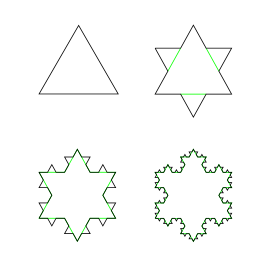
Back بعد هاوسدورف Arabic Хаусдорфова размерност Bulgarian Dimensió de Hausdorff-Bezikóvitx Catalan Hausdorffova míra Czech Hausdorff-Dimension German Διάσταση Χάουσντορφ Greek Dimensión de Hausdorff-Besicovitch Spanish Hausdorffin dimensio Finnish Dimension de Hausdorff French ממד האוסדורף HE

In mathematics, Hausdorff dimension is a measure of roughness, or more specifically, fractal dimension, that was introduced in 1918 by mathematician Felix Hausdorff.[2] For instance, the Hausdorff dimension of a single point is zero, of a line segment is 1, of a square is 2, and of a cube is 3. That is, for sets of points that define a smooth shape or a shape that has a small number of corners—the shapes of traditional geometry and science—the Hausdorff dimension is an integer agreeing with the usual sense of dimension, also known as the topological dimension. However, formulas have also been developed that allow calculation of the dimension of other less simple objects, where, solely on the basis of their properties of scaling and self-similarity, one is led to the conclusion that particular objects—including fractals—have non-integer Hausdorff dimensions. Because of the significant technical advances made by Abram Samoilovitch Besicovitch allowing computation of dimensions for highly irregular or "rough" sets, this dimension is also commonly referred to as the Hausdorff–Besicovitch dimension.
More specifically, the Hausdorff dimension is a dimensional number associated with a metric space, i.e. a set where the distances between all members are defined. The dimension is drawn from the extended real numbers, , as opposed to the more intuitive notion of dimension, which is not associated to general metric spaces, and only takes values in the non-negative integers.
In mathematical terms, the Hausdorff dimension generalizes the notion of the dimension of a real vector space. That is, the Hausdorff dimension of an n-dimensional inner product space equals n. This underlies the earlier statement that the Hausdorff dimension of a point is zero, of a line is one, etc., and that irregular sets can have noninteger Hausdorff dimensions. For instance, the Koch snowflake shown at right is constructed from an equilateral triangle; in each iteration, its component line segments are divided into 3 segments of unit length, the newly created middle segment is used as the base of a new equilateral triangle that points outward, and this base segment is then deleted to leave a final object from the iteration of unit length of 4.[3] That is, after the first iteration, each original line segment has been replaced with N=4, where each self-similar copy is 1/S = 1/3 as long as the original.[1] Stated another way, we have taken an object with Euclidean dimension, D, and reduced its linear scale by 1/3 in each direction, so that its length increases to N=SD.[4] This equation is easily solved for D, yielding the ratio of logarithms (or natural logarithms) appearing in the figures, and giving—in the Koch and other fractal cases—non-integer dimensions for these objects.
The Hausdorff dimension is a successor to the simpler, but usually equivalent, box-counting or Minkowski–Bouligand dimension.
- ^ a b MacGregor Campbell, 2013, "5.6 Scaling and the Hausdorff Dimension," at Annenberg Learner:MATHematics illuminated, see [1], accessed 5 March 2015.
- ^ Gneiting, Tilmann; Ševčíková, Hana; Percival, Donald B. (2012). "Estimators of Fractal Dimension: Assessing the Roughness of Time Series and Spatial Data". Statistical Science. 27 (2): 247–277. arXiv:1101.1444. doi:10.1214/11-STS370. S2CID 88512325.
- ^ Larry Riddle, 2014, "Classic Iterated Function Systems: Koch Snowflake", Agnes Scott College e-Academy (online), see [2], accessed 5 March 2015.
- ^ Keith Clayton, 1996, "Fractals and the Fractal Dimension," Basic Concepts in Nonlinear Dynamics and Chaos (workshop), Society for Chaos Theory in Psychology and the Life Sciences annual meeting, June 28, 1996, Berkeley, California, see [3], accessed 5 March 2015.
© MMXXIII Rich X Search. We shall prevail. All rights reserved. Rich X Search
